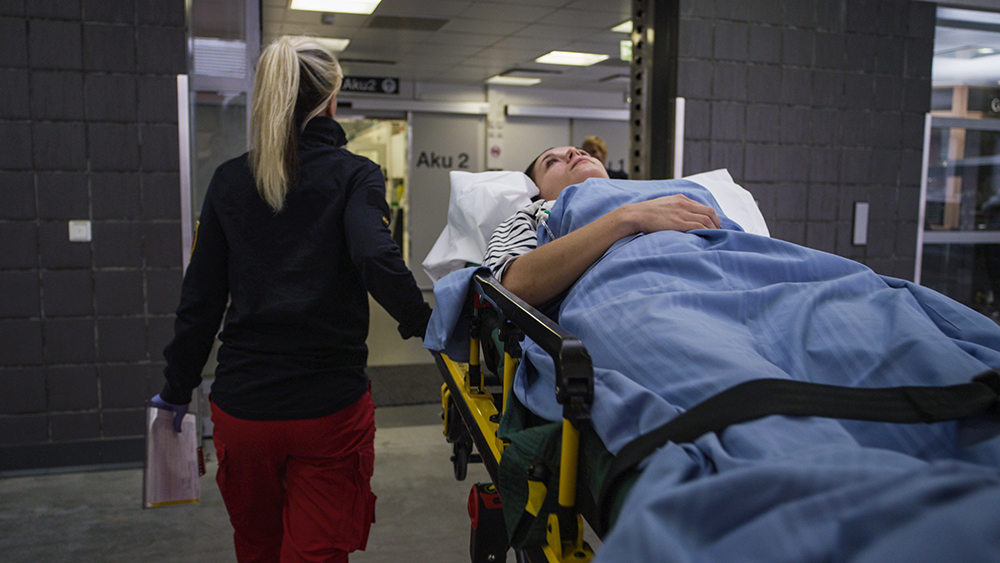Task prioritisation makes it possible to provide help in acute emergencies

The Emergency Response Centre Agency’s guidelines for handling prehospital emergency care tasks were revised at the end of November 2023. The change is reflected in the number of tasks assigned to prehospital emergency care and in their priority distribution.
In November 2023, the emergency medical services centres of the collaborative areas for social welfare and healthcare services issued revised guidelines for handling prehospital emergency care tasks to the Emergency Response Centre Agency. The objective of the guidelines is to ensure that the tasks relayed to prehospital emergency care services correspond to genuine needs.
Whereas the previous guidelines prioritised speed, the focus is now on relevance. The reform is reflected as an increased emphasis on providing callers with instructions on how to seek treatment independently, rather than always sending an ambulance.
The correct type of help already in the first stage
The implementation of the new task handling guidelines was immediately visible, and the change has also been permanent. The number of tasks relayed to prehospital emergency care services has decreased, and the share of urgent tasks is now lower. This is consistent with the objective of the guidelines, i.e. directing the person requiring medical attention to receive the correct type of help already in the first stage.
“In 2024, the number of tasks relayed to prehospital emergency care services decreased by 93,000 compared to the previous year. The choice of not relaying a task is always made by a professional. Not being sent the ambulance that you wanted does not mean that you are left without help. Help is found in another form within the health services” says Branch Manager Ari Ekstrand.
Upon conducting a risk assessment, the ERC operator may conclude that the person calling the emergency number should seek medical assistance, but does not need prehospital emergency care. The staggered use of healthcare services (local health centre, Medical Helpline 116117, emergency department and prehospital emergency care) makes it possible to provide help to emergency patients quickly.
“Help is still available. However, prehospital emergency care resources must be allocated in such a way as to allow emergency patients to be reached quickly. This requires the assessment and prioritisation of situations and efficient use of resources. An ambulance must not be delayed because it is on the other side of the city cleaning a wound that could have been treated at an emergency room that one of the patient’s loved ones could have driven them to, for example,” Ekstrand adds.
Personnel satisfied
The changed guidelines have been welcomed by paramedics. Based on a wealth of collected feedback, patients are now directed to the right type of help from the get-go, overloading has decreased and job satisfaction has increased. Increased job satisfaction is also being reported by ERC operators, whose discretion is now emphasised.
“Carrying out assessments over the phone always has its own challenges, and there have always been cases of responses being excessive or insufficient. In the past, however, excessive responses were a clear challenge,” Ekstrand adds.
Changes in society are quickly heard on the emergency line. For example, the ageing of the population and the overloading of mental health services have contributed to increasing demand for social welfare and healthcare services. The changing operating environment also requires continuous monitoring and updating of operating models and guidelines.
“We are constantly working with our branches to ensure the best possible help in times of distress. We also closely monitor the number of complaints, and have noticed an increase in the number of complaints about emergency calls concerning prehospital emergency care. We take these complaints very seriously. That being said, it is important to keep in mind that in 2024 we responded to more than 910,000 emergency calls concerning prehospital emergency care, which resulted in 733,000 tasks being relayed to prehospital emergency care services. Of these emergency calls, only 64 led to complaints. This speaks of strong expertise,” says Ekstrand.
Customer satisfaction at an excellent level
A customer satisfaction survey conducted in autumn 2024 asked those who had called the emergency number to evaluate the service in four areas: speed of the emergency call being picked up, clarity of the instructions provided by the ERC operator, the service-mindedness of the ERC operator and the expertise of the ERC operator. The survey also included a new question concerning the customer's perception of whether they received the help that they needed.
“Most of the respondents (93%) felt that they received the help that they needed. This sentiment was slightly higher than average among those calling in situations requiring prehospital emergency care (96%). Those calling in situations requiring prehospital emergency care were also more satisfied than average with how quickly their call was picked up,” says Head of Quality of the Emergency Response Centre Agency Emma Paasonen.
Tutustu myös
Jaa vaaratiedote kaverille 112 Suomi -sovelluksen avulla
Sijaintitieto voi pelastaa hengen
Hätäkeskuksissa varaudutaan päättäjäisviikonloppuun
Saako ihminen ambulanssin?
112 Hätäkeskus -podcastin uuden tuotantokauden ensimmäisessä jaksossa pureudutaan ensihoitoon – mitä se tarkoittaa, kuinka se eroaa vanhanaikaisesta sairaankuljetuksesta ja miksi hätäpuhelussa on tärkeää vastata kysymyksiin.
Nuoret miehet 112-päivän kohderyhmänä 2026
Kampanjan avulla halutaan vahvistaa nuorten miesten rohkeutta puuttua hätätilanteisiin.
Hyvinvointia rakennetaan yhdessä
Ammattitaitoinen, sitoutunut ja hyvinvoiva henkilöstö on Hätäkeskuslaitoksen tärkein voimavara ja strateginen painopiste. Uudessa työhyvinvointiohjelmassa painotetaan aiempaa vahvemmin mm. työkykyjohtamisen osaamisen kehittämistä ja työurajohtamista.
Synnytyspuhelussa hätä voi muuttua iloksi
Hätäkeskuksesta välitetään vuosittain yli 2240 synnytykseen liittyvää tehtävää. Hätäkeskuspäivystäjälle kokemus on ainutlaatuinen, kun puhelimen päässä kuuluukin uuden elämän ääni.
Hätänumeroon kuulumattomien ilmoitusten määrä laskussa
Hätäkeskuslaitoksen puolen vuoden tilastot osoittavat, että hätänumeron virheellinen käyttö on vähentynyt. Hätäkeskusten resurssit painottuivat alkuvuonna aiempaa enemmän kiireellisten hätäilmoitusten käsittelyyn.



